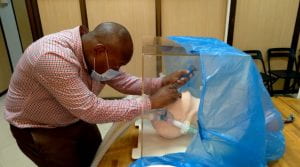It’s hard to believe that we’re already one week into this internship! Before we started, I was curious about how having a virtual internship would go and nervous about not knowing what exactly to expect. Could I still get to know my teammates through a computer screen? How would we navigate our drastically different time zones? Despite all my questions and bundle of nerves, I clicked join on our first day of group workshops and my worries went away. In this past week, it’s been incredible to see the work that the Rice 360 faculty has put into this internship and the great plans they have for us to learn about global health, build relationships with fellow interns and faculty, and make an impact on the technologies for COVID-19 in low-resource settings.
On our first day, we went over the general plan for the internship, what they expected of us, and, finally, we were assigned our teams and prototypes (exciting!). My team is distancing devices, and my fellow members are Austin Hwang from Rice University, Chikumbutso Walani from the University of Malawi The Polytechnic, and Ruth Mtuwa from the Malawi University of Science and Technology (MUST). After some initial research of our assigned prototypes and problems, we had presentations the following day from the Malawi design studios covering the full extent of our technologies.

The first technology my team will be working on is the intubation box. With the outbreak of COVID-19, a significant number of infected patients develop respiratory failure and ultimately require endotracheal intubation; however, since COVID-19 is transmitted through droplets and aerosol, providers intubating these patients are put at high risk of contracting the virus. Ideally, providers wear powered air-purifying respirators, but with the large expense and world-wide shortage, health care professionals have looked to other venues to provide a barrier between the physician and the patient. This solution is the intubation box, which is a clear box placed over a patient’s head with armholes on one side so that the physician can intubate the patient. The goal of our work on the prototype is to iterate on the current design and move the technology to be able to be mass-produced using resources sourced locally in Malawi.
Our second technology is a prototype for a contactless temperature monitor. With COVID-19, there is a need for monitoring body temperature at a safe distance and contactless thermometers are an already-developed solution. However, these monitors can be expensive and difficult to access in low-resource settings. For this reason, the goal for the project is to produce a contactless temperature measuring device, based on currently available designs, that is made using resources available locally in Malawi. After the introduction of our prototypes, the remainder of the week consisted of workshops over design criteria, global collaboration, and a wonderful presentation on human-centered design from the Rice TAs. We also had our first informal presentation to members of the Rice 360 technology team, who provided insightful feedback and suggestions for our work as we go forward.
My team and our TA Alex ended the week with a virtual group meal on Saturday when it was lunchtime here in Texas and dinnertime in Malawi. It was a much needed time of talking and laughing with each other in a relaxed environment, and I loved being able to see my teammates’ faces and their expressions with our videos on. During our virtual group bonding, my favorite topic of conversation was food trends in the United States that my teammates in Malawi found curious, namely the wonder that is fried chicken and waffles (very delicious and I highly recommend), and if the famous Popeyes chicken sandwich is worth it. We’re planning on having a virtual cooking class where Chikumbutso and Ruth will teach us how to make nsima, a traditional dish from Malawi, so keep an eye out for how it went in one of my future entries! On top of silly conversations about cats vs dogs and our favorite TV shows, we also had the opportunity to discuss the effects of COVID-19 on our respective communities and our thoughts of how it’s been dealt with, and it was great to have the opportunity to see the perspectives of my fellow teammates.
To wrap-up my first blog post, I want to talk about challenges we can all face when we’re coming into a new project with less experience than those around you. I’ve worked previously on two global health projects, one being a teaching model for anal cancer screening through the Rice GLHT 360 course, and the other being a device for treating late-stage cervical cancer through the Rice GLHT Capstone Design course this past year. Coupled with my non-engineering background (I’m studying kinesiology and biochemistry), I’ve had limited experience with electronic design and that side of engineering, and I have focused more on the clinical side of the field. I was nervous coming into the internship knowing that it was likely I’d be assigned to an electronics-type device, but with the help of my teammates, their vast experience, and our Rice 360 advisors, I’m confident that I’ll be able to find the best ways that I can contribute to our contactless temperature monitor. From Chikumbutso’s Lauren-level explanation of IR sensors to Austin’s knowledge of signal amplification and filtering (I’m still working on this one) or Ruth’s understanding of materials and design, I’ve already learned so much from my team members in just one week. I’m looking forward to continuing to learn from them and our internship presenters and working on what is next for our prototypes and the internship.
See you next week!
Lauren